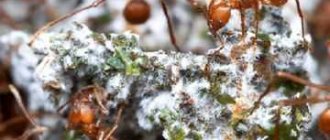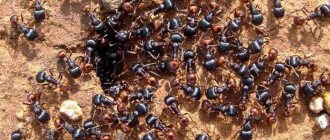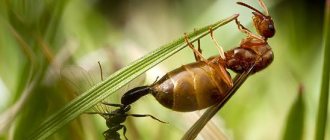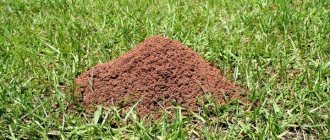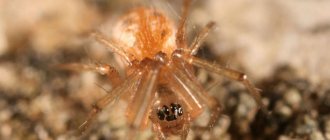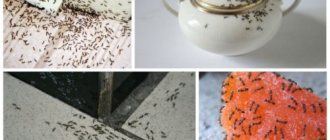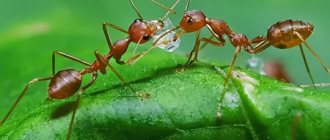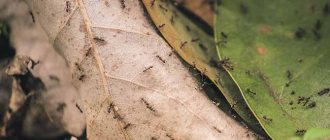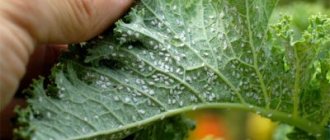Ants belong to the superfamily Antidae of the order Hymenoptera. These amazing insects have existed on the planet since the time of dinosaurs; they create colonies of up to several million individuals. More than 12 thousand species of ants are known, whose total weight is equal to the total weight of all humanity - for every inhabitant of the earth there are a number of ants equal to his weight.
Ants can create symbiosis with plants or other insects, lift a weight several thousand times their own, and also “accelerate” up to 7.6 cm per second, which is approximately 53 km per hour by human standards. These babies are also able to learn by watching others, “hear” with their feet and distinguish each other by smell - each colony has its own. Let's understand the structure of the ant's body to better understand these amazing insects.
Features of the structure of an ant
Insects of the ant family belong to the order Hymenoptera and in their morphology resemble their closest “relatives” - wasps and bees. Different types of ants are very similar in structure, but have some differences depending on their lifestyle or habitat.
The anatomical structure of their body is quite complex. It is perfectly thought out by nature so that these insects have the opportunity to move long distances at good speed, lift heavy loads, attack opponents and defend themselves from natural enemies, and also perform their work functions in accordance with the social hierarchy of the anthill.
Where live
These tiny workers are widespread on all continents, with the only exception being Antarctica. Insects live in anthills that they build themselves. The founders of such nests are females (queens), whose function is not only to procreate, but also to select a suitable place. Each colony has only one queen. All the other inhabitants of the anthill feed and protect her. A photo of the anthill where the ants live can be seen below.
Anthills
Male ants die almost immediately after mating with a female. Worker ants, or foragers as they are also called, take care of the rest of their family by delivering food to them. Another function of worker ants is to protect the anthill from attack by enemies.
However, not all types of ants are clearly divided into castes. So black garden representatives devote the beginning of their lives to caring for eggs and larvae, in the next stage of their life they build a nest, and later their function is to obtain food. As a result, the anthill contains the largest number of living individuals.
External structure
The body of the ant is covered with a durable chitinous shell. It is divided into 3 main parts - head, chest and abdomen. The diagram of the body structure and anatomy of an ant is presented in the photo.
The chitinous exoskeleton serves to protect against various external damage and is the basis to which skeletal muscles are attached. It is thanks to him that these tiny insects can carry a load several tens of times greater than their own weight.
This is interesting! The smallest species of ants are able to lift objects 50 times heavier than themselves, and larger representatives - only 10-20 times. The smaller the insect, the more powerful it has. It depends on the structure of the muscular system.
Head
On the ant’s head there are two types of eyes (simple and faceted), antennae, as well as a clypeus and mandibles, otherwise called mandibles.
Small but powerful jaws capture and chew food. In the preoral chamber, it is divided into edible and inedible particles.
Most of the space inside the head is occupied by the muscles that control the mandibles. Their largest sizes are recorded in soldier ants. They use them to collect food, clear it of dirt, and also to capture or destroy prey. In addition, such large jaws give them an advantage in battles with opponents, causing significant damage to their enemies.
Eyes
Different species of ants have slightly different organs of vision. Depending on their living conditions and the structure of their eyes, these insects can see only a few centimeters or up to hundreds of meters ahead. And in the soil, for example, absolutely blind ants live.
The visual organs on the head are represented by large compound eyes and three simple ocelli.
The latter are designed to determine the characteristics of the environment, for example, illumination or the plane of inclination of the surface.
The compound eyes of an ant have a complex structure and consist of individual particles - ommatidia. Their outer lenses fit tightly together and resemble the shape of hexagons on the outside, which are called facets. This is where their name comes from.
Despite the complex structure, the ant’s organs of vision have a rather low resolution, so it is quite difficult for insects to distinguish the shape of an object, but they respond well to movement.
Mustache
Ants lack noses, ears and taste buds, but their antennae are a universal sense organ. They are responsible for touch, smell and taste at the same time, and consist of manubrium, flagella and frontal ridges.
Fact! This morphological structure of the antennae is found in nature only in ants.
With their help, insects recognize molecules of various substances, sense air currents and vibrations, and also receive external signals from the environment and other insects. The antennae transmit information to the brain about the tastes, smells and textures of objects around them. Ants can even transfer this data to each other.
The smell is perceived by the flagella of the antennae; insects can distinguish its subtlest shades. And tastes are recognized through numerous plates riddled with pores. Thanks to such unusual sensory organs, ants can distinguish between clean and dirty water, mineral impurities and chemicals in its composition.
For touch and tactile sensations, insects, in addition to their antennae, use small, hard hairs throughout their body.
On a note! Ants, with their antennae, are good at picking up air vibrations and can even predict an earthquake! But they don’t have ears, so they are not able to recognize sound waves.
Communication between insects also occurs through the antennae. Special touches with their flagella, gestures with their paws, combined with the release of pheromones, make up the unique language of ants.
Sternum
The sternum contains the anterior pair of legs and defensive organs. The queen ant and some species of ants also have wings there, which are chewed off after performing the reproductive function.
Between the chest and abdomen there is a kind of “waist” - petiole, which consists of 1-2 segments.
Abdomen
The abdomen contains the heart, reproductive organs, endocrine glands and the main part of the digestive system - the crop and intestines, as well as a toxic chemical substance for attack or defense.
A goiter is a blind extension of the esophagus in which remnants of digested food can be stored. This is the so-called "social stomach" because its contents can be passed on to other members of the nest. Some types of insects even have special individuals - feeder ants, which are responsible for storing food supplies.
Also located here is the main component of the developed endocrine system of ants - Dufour's gland, which secretes special pheromones. With their help, insects communicate and track each other's paths. For example, scout ants look for food, rush to the nest to report information to workers, and then return to the found source by the smell of their tracks.
Important! If you find a lone ant in the kitchen and kill it, most likely other scouts will follow its trail. Therefore, it is important to track its path and rinse everything thoroughly to remove all odors that are elusive to the human nose.
Some species of ants have a sting on their abdomen (an evolutionarily transformed ovipositor), with which you can hit an enemy and inject him with poison. Other varieties have a special hole from which formic acid is sprayed to protect against external danger.
Paws
An ant has three pairs of legs on its body. Each of them is divided into three components - a thigh, a lower leg and a tarsus, which ends in two hook-shaped claws and an adhesive pad. With their help, insects can easily stay on a smooth vertical surface.
Between the body and the leg there is a small hinged mount that connects them to each other - the trochanter. It is so small that it can only be seen under a microscope.
Thanks to this structure of the limbs, ants have high mobility. The front pair of legs can rightfully be considered “hands” in the full sense of the word. With their help, the ant performs different types of work, since they are the strongest.
The secret of strength
It has long been known that ants are very strong and can carry an object whose weight is many times greater than their own. And how much an ant can lift depends on the type of insect. The smallest representatives of the family are able to lift a load 50 times heavier than themselves, while larger species can carry an object weighing only 10-20 times more than they weigh. It turns out that the smaller the individual, the stronger it is. The strength of these weightlifters is explained by the special structure of their muscular system and the presence of a very strong chitinous shell, which performs mechanical and protective functions.
Internal structure of an ant
The internal structure of an ant is very functional. The structure of all organs and systems is thought out by nature to the smallest detail.
- The central nervous system consists of several types of nerve ganglia called ganglia: suprapharyngeal (the largest, performing brain functions), subpharyngeal, thoracic and abdominal. The ant's brain consists of 250-500 thousand neurons and is capable of forming a large number of temporary connections. It has been proven that it is much more developed in socially organized insects living in groups than in solitary individuals.
- Circulatory system
The so-called “blood” of ants is a transparent, colorless liquid - hemolymph. It is not distributed throughout the body in arteries and veins, as in humans, but circulates freely, thanks to the work of a special vessel that acts as the heart. In structure, it is a muscular tube, and runs along the entire dorsal surface of the ant’s body.
- The respiratory system of an ant consists of trachea and spiracles (stigmas), which are located on different parts of the insect’s body: between the mesothorax and epinotum (metathoracic), on the epinotum, on the stalk at the base of the scale and on the abdominal segments. Insects do not have lungs, so the breathing process occurs in a special way - through microscopic pores on the chitinous coating, through which the spiracles pass.
What do ants eat?
Another feature of these goosebumps is the ability to adapt to their environment. Therefore, these insects are omnivores. In the spring and summer, food is supplied to the anthill every day by worker ants. With the arrival of cold weather, not all ant families hibernate. As a result, they are forced to stock up on winter food in advance.
Goosebumps distribute food like this:
- The queen feeds exclusively on protein. Very often, food intended for the queen is supplied by worker ants already chewed.
- Worker ants have a carbohydrate diet. This includes the soft parts of berries and fruits, plant juices, their roots and seeds. With particular pleasure they eat honeydew, which is released by the plant during a sharp change in temperature. Another favorite delicacy of goosebumps is the sugar milk of aphids (honeydew). In red forest ants it makes up the majority of the diet. Such food is more nutritious and easily digestible.
- The larvae emerging from the pupa prefer protein foods, which are contained in the remains of small insects, as well as in the eggs of various pests. For example, domestic ants are not averse to eating even the owner’s food: cottage cheese, meat, cheese or eggs. The younger ant generation will not refuse domestic Prussian cockroaches.
Types of ants
Scientists still debate which order the ant belongs to. The difficulty of classification is associated with the huge number of twin species and all kinds of hybrids. The ant family includes 21 to 26 subfamilies, 54 tribes, 378 genera, and more than 13,000 species.
Like their closest relatives - wasps, ants are part of the order Hymenoptera, but because of their originality they were separated into a separate superfamily. Each species has its own characteristics, both in appearance and in its way of life, and differ in biology, organization and behavior.
Black garden ant
This species is considered the most common species, since similar ants are found in almost all corners of our planet. Working individuals grow up to 4 and a half mm in length. Males are not significantly characterized. but large in size (up to 5.5 mm), and females have a length from 7 and a half to 11 millimeters. The body of the classic garden ant is covered with short, sparse bristles. They nest deep in the ground, under large stones, and also in unusable (rotten) wood. The main source of food for garden ants is the sweet liquid secreted by aphids. Therefore, ants not only protect aphids, but also breed them on various garden crops, which is why they can cause significant harm to the future harvest. What is interesting: the life expectancy of the queen is about 30 years, which is a record value for this category of insects.
Red myrmica
This type of ant has become widespread both on the European continent and in the Urals, Siberia and the Far East. Females of this species are reddish, up to 6 mm in length, and males are almost black and slightly smaller in size (up to 5 mm). On the body of this species you can also see, albeit sparse, short hairs. They form their nests in the ground, under boulders or under fallen tree trunks.
Small forest ants
They prefer to settle in forests with a temperate climate, distributed throughout the Euro-Asian continent. Ants are distinguished by a red-brown body color, with red cheeks and a black abdomen. They grow in length from 7 to 14 mm. Forest ants form anthills up to 2 meters high in forests. Needles and branches are used as building materials. The species is listed in the Red Books of many countries with endangered species status. Therefore, in some countries, as well as in certain regions, this insect is extremely rare.
Pharaoh ant
This ant received this name due to the fact that it is endemic to Egypt. Their colonies settled at low speed on almost all continents. Working insects are yellow in color and reach a length of no more than 2 millimeters. Males differ from females in the presence of wings and black body color. They can reach a length of up to 3.5 millimeters. Females, in turn, reach a body length of about 4.5 millimeters and are colored yellow-brown. Young female ants have wings, but after mating, the worker ants bite off their wings. These ants are found in dark and damp places, setting up anthills within the same residential building.
Dinoponera gigantea
This representative received special fame due to its gigantic size. Individuals of this species are capable of reaching about 33 millimeters in body length. Their bodies are painted black. Males are distinguished by the presence of wings, but the queens of this species do not exist at all. Instead, they use working individuals - females. These large ants are found only in humid forests and savannas of South America. They make their home at a depth of about 40 centimeters.
Asian tailor ant
This ant can be found without problems in Australia, Vietnam, Thailand, Bangladesh, as well as in South India in tropical and subtropical climates. This species of ant is distinguished by its bright green color. At the same time, the abdomen is painted in red-orange tones, and the legs are beige. Working individuals are up to 8 mm in length, with males growing up to almost 1 cm in length, and females up to 1.3 cm in length. They prefer to live in trees in colonies of 500 thousand individuals, or even more. Therefore, a colony can occupy several trees at once. They build their nests from leaves, which are connected to each other using the characteristic sticky secretions of the larvae. That's why they were called "tailors".
The population of these places uses the larvae and pupae of these ants as food for poultry, as well as in traditional and folk medicine, including in the national cuisine of some Asian countries.
Eastern Liometopum
It is considered a species that is in danger of extinction, since it is listed in the Red Book, while it is an inhabitant of the Far East. Working individuals are dark brown in color and measure about 6 mm in length. Males and females are almost black and grow to 10 and 12 mm in length respectively. They build their nests in Korean pine, fir, Mongolian oak, linden, birch, etc.
Yellow Amazon Ant
These ants are distinguished by their rather large size. Females are capable of reaching a body length of about 1 centimeter, and males, in turn, do not exceed 0.75 centimeters in length. Working ants are no more than 0.7 centimeters. As a rule, all females and worker ants are colored red and yellow, and their bodies are covered with small black hairs. Males are completely black with brown antennae. These insects are found in European countries, as well as in Asian countries and western Siberia. Yellow Amazon ants prefer moist forests as their habitat, and build their nests in clearings and forest edges. They tend to kidnap other types of ants and use them as additional labor.
Blood red ant
It has received separate distribution in European countries, as well as in central Russia, China and Mongolia. Working ants reach a body length of about 8 millimeters. Their body is black with an orange head. The queen of blood red ants reaches 10 millimeters in body length and has a red head with an orange chest. These ants make summer nests on rotten stumps, as well as in the ground or under stones. In winter, they change nests to those located near the base of trees. They also differ in that they can carry out robberies on other anthills. They use the captured pupae as “slaves”.
Amazon Ant
Females of this species grow up to 1 cm in length, while males are 2 times smaller, and their “soldiers” are even smaller. The color of females and “soldiers” is yellow-red, and there are black hairs on their body. Males of this species are black in color, with brown antennae and limbs. This type of ant is common in the European part of the continent in western Asia and western Siberia. The species prefers to settle in forests, giving preference to damp areas, near clearings and forest edges. The Amazon ant also practices raids on colonies of other ants and takes pupae with them, after which it keeps them as labor.
Nomadic ants or legionnaire ants
This ant species is a subfamily of nomadic ants, which is common in tropical climates. Entire colonies of these dangerous insects are found in Central and South America, as well as within the African continent. They live in numerous colonies, consisting mainly of working individuals. Despite their relatively small size (no more than 4 mm), colonies of these insects are capable of destroying everything in their path. At the same time, they cause enormous damage to farmland.
Lifestyle and habitat
Due to the large number of species, the life of ants influences biogenesis. By creating anthills, they actively loosen the soil, saturating the roots of plants with air and moisture. Inside houses there is a warm and humid atmosphere in which bacteria actively multiply, processing waste products and excrement. Thus, insects help saturate the soil with nutrients.
The ant is a social insect, the structure of their communities is similar to that of humans, characterized by a clear structure in which the distribution of roles plays a vital role. Some species, in addition to the three main castes, have an additional one - soldiers, they serve as protectors of the anthill, for this the workers provide them with food.
A special variety of insects, fire ants , subjugate representatives of weaker families and parasitize at their expense. In any case, the anthill is a single organism, without which individual individuals cannot survive.
Ants have settled across all continents and climatic zones with the exception of deserts, Antarctica and the cold islands of the Atlantic and Arctic oceans. Each species has its own habitat, but ants are able to move even between countries and continents, forming new colonies where they were not previously settled.
At the same time, stronger varieties are able to displace weaker ones from their usual places. Life in a warm climate allows insects to reach impressive sizes for the family and continue their life activities year-round; ants in temperate and cold zones are much smaller and hibernate in the winter.
Most species organize their homes in the form of anthills; these can be earthen dwellings, settlements in tree bark or rotten stumps; special species are able to capture bird nests and settle in them.
Does myopia interfere with ants?
It may seem to a person that an ant's vision is rather poor and these insects see only under their noses, and therefore experience difficulties in this regard. But such vision in ants was formed through evolution and is quite sufficient for a full life!
Ants, like cats, are more focused not on vision, but on smell and tactile sensitivity. When observing an anthill, you may get the impression that the ants' vision is quite sharp, even at night.
However, this is not the case. Do ants see approaching danger in the dark or in the light? In the classical sense, no. But they perfectly sense movements around them and are guided by olfactory marks
and literally pick up the slightest vibrations, using their own body as a resonator.
See what's included in each kit:
Source
Reproduction
All reproduction is carried out in several ways and occurs twice annually.
- During the first method, the queen with a certain number of workers separates from the society and creates a new anthill.
- Another option is a mating flight, in which a female from a foreign anthill is fertilized by several males. Then she lays eggs, from which worker ants are born. Males die after a certain time. Until the workers emerge, the female feeds on the remains of the wing muscles. Females and worker ants are born from fertilized eggs, and males from unfertilized eggs.
These insects are completely harmless, of course, when they do not look after human housing for their place of residence. Therefore, there is no need to simply exterminate them: after all, the ant is an important link in the ecological chain.
Interesting facts from the life of ants
Did you know that:
- the amount of intelligence (learning) in ants reduces their lifespan and fertility
- a worker ant has a brain (mushroom bodies) almost twice as large as a soldier's
- Of the total number, only 3% of ants constantly work in anthills; 25% of individuals have never been seen at work. And 72% of insects either work or don’t work, about half the time
- Scout ants are the intellectual elite of the anthill; they transmit encoded texts of the movement route to each working individual and make up about 1% of the entire population of the anthill
- “Circles of death” in legionnaire ants occur due to a failure of orientation on the terrain; they begin to move one after another at the level of pheromones and twist into a spiral. The weakest die in the center of this circle
- The collection of milk (honeydew) from aphids is carried out by a special caste - shepherds. With their paws they tickle aphids, getting them to secrete droplets of honeydew and pass them on to workers for transportation.
- some species (leaf cutters) have divisions of workers (subcastes): some (small in size) work only inside the anthill, never leaving it. And others (large sizes) are only outside, ensuring the cutting and delivery of leaves.
Sense organs
On the ant's head there is a pair of eyes, consisting of about six thousand facets - small hexagonal eyes connected directly to the brain. That's quite a bit. For example, the eyes of dragonflies consist of approximately thirty thousand of these facets.
Some ant species also have additional, so-called simple eyes.
. They are located on the parietal part of the head and look like three small black dots.
The structural features of the ant's eye are such that the ant can only look straight ahead and does not see what is happening on the sides. In addition, ants, for the most part, are quite short-sighted.
If we talk about how ants see the world around them, it can be noted that they clearly distinguish only objects that are right under their noses, at a distance of no more than three to four centimeters. Objects located at a distance of more than seven or eight centimeters are already seen as blurred by him.
Insects can detect movement and distinguish large objects at a distance of up to five meters
. Since ants live in their own microcosm, they do not need to see over long distances.
Lifestyle
An ant family is formed over many years, as a result of which the number of inhabited anthills can be several million (these are already colonies located near each other over vast territories). Ant society is divided into three castes: females, males and workers. Taking into account the class, a division of labor occurs, and everyone from the queen to the worker must perform their functions at the proper level (if they fail to cope with their duties, the queen is removed and the worker is killed).
It is not difficult to distinguish representatives of the three castes by external characteristics: while females and males have wings, workers (females with an underdeveloped reproductive system) do not. True, after fertilization, the queen’s wings usually either fall off, or she chews them off for herself, but even in this case, she can be distinguished by her enormous size. While queens and workers emerge primarily from fertilized eggs, which contain the two sets of chromosomes they received from the egg and sperm, males emerge from unfertilized ones. Before turning into an adult, the red, red, black ant goes through the stages of egg, larva and pupa.
Ant protection
Aneuretus simoni
Although most ant species are resistant to many attempts by humans to eradicate them, some species are at risk of decline or extinction. These are mostly island species that have evolved specialized traits, including Aneuretus simoni from Sri Lanka and Adetomyrma from Madagascar. There are 149 ant species listed on the IUCN Red List of Threatened Species. The eastern liometopum is included in the Red Book of Russia (category 2, a declining species).
By 2009, in 15 constituent entities of the Russian Federation, 30 species of ants were included in the regional Red Data Books (or in the relevant regulations on the protection of rare and endangered species of organisms). In some European countries, the nests of red wood ants are protected and settled. Since 1971, the All-Russian Operation Ant was carried out in the RSFSR to map, protect and resettle beneficial species of forest ants of the genus Formica. In Russia, the destruction (ruin) of anthills is an administrative offense, for which a fine of 300 to 500 rubles or a warning is provided.
Relationship between ants and people
Surely, if you have a summer house, then you have encountered such a problem as ants in the garden.
The vegetable garden or flowers suffer greatly from ants, because the ants simply eat various berries and herbs.
Summer residents have already put forward many ways to combat such garden parasites.
Danger to people
0 Crawling somewhere on rotting food debris and sewage, and then getting on food, ants are able to act as carriers of all kinds of human diseases: diphtheria, typhoid, etc. Any food product can suffer from an ant invasion. The secretive placement of nests and the inability to effectively use contact poisons to reduce their numbers seriously complicate the fight against these insects. Usually the most effective method is the bait method, which is based on the characteristics of a given biological species to transfer its food from the mouth of one individual to the mouth of others that are in the nest.
Eating
Ants and their larvae are edible and consumed in various parts of the world. The “eggs” (pupae, larvae) of two species of ants from the genus Liometopum serve as the basis for the preparation of a dish known in Mexico as “escamoles”. They are regarded as a form of caviar (or insect eggs) and are sold at a high price, approximately $90 per kg, due to the fact that they are a seasonal and difficult-to-discover resource. In South America (in the Santander department of Colombia), large-bodied ants, known locally as “hormigas culonas” (leaf-cutter ants of the species Atta laevigata), are collected, which are fried alive and eaten.
In various parts of South (India) and Southeast Asia (Myanmar, Thailand), green weaver ant paste is used as a seasoning for vegetable (or meat) curry. Eggs and larvae of weaver ants, as well as their adults, are used in the preparation of Thai yum salad, in a dish called yum khai mod daeng or red ant egg salad (a dish originating from the Isan region in the north). eastern Thailand). Weaver ants are also used as food by the aborigines of Australia (North Queensland). Mexican Indians eat worker ants known as "honey barrels."
